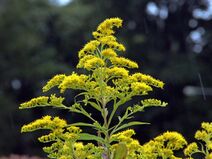Solidago gigantea
| Solidago gigantea | |
 | |
| Light: | |
| Moisture: | |
| Hardiness: | 6 |
| Soil pH: | 5.6-8.4 |
| Height: | 4' |
| Blooms: | Early Fall |
| Native to: | |
| Shelter Nectary | |
| Medicinal Rating: | |
| Tea: | Yes |
Solidago gigantea (common name: giant goldenrod)
Propagation: Seed - sow spring in a cold frame. Only just cover the seed and do not allow the compost to become dry. Prick out the seedlings into individual pots when they are large enough to handle, and grow them on for their first winter in pots. Plant them out into their permanent positions in spring or early summer.
Division in spring or autumn. Larger divisions can be planted out direct into their permanent positions. We have found it best to pot up the smaller divisions and grow them on in a lightly shaded position in a cold frame, planting them out once they are well established in the summer.
Cultivation: Succeeds in any moderately fertile moisture retentive soil in sun or semi-shade[1]. Grows well in heavy clay soils.
A rather greedy plant, it is apt to impoverish the soil[2]. This species has become a weed in its native range, increasing freely by seed and at the root[1].
The plant attracts various beneficial insects such as ladybirds, lacewings and hoverflies to the garden, these insects will help to control insect pests in the garden[3][4].
Range: N. America - New Brunswick to British Columbia, south to Georgia, Texas and Utah.
Habitat: Low wet areas, roadsides, pond margins and the sides of streams, generally in mesic areas[5].
Medicinal: The leaves and blossoms are astringent, cathartic and styptic[6]. They are a valuable remedy in the treatment of all kinds of haemorrhages[6]. An infusion of the blossoms has been used to treat various fevers[7].
An oil obtained from the plant (is this an essential oil?) is diuretic[6].
Usage: The stems can be made into rough baskets[7].
Pollinators: Insects
Soil: Can grow in light, medium, and heavy soils.
Flower Type: Hermaphrodite
Heavy Clay: Grows in heavy-clay soils.
Also Known As: S. pitcheri.
Links
References
- ↑ 1.0 1.1 Huxley, Anthony. The New Royal Horticultural Society Dictionary of Gardening. MacMillan Press, 1992.
- ↑ Chittendon, Fred. RHS Dictionary of Plants. Oxford University Press, 1951.
- ↑ Allardice, Pamela. A-Z of Companion Planting. Cassell Publishers, 1993.
- ↑ Bown, Deni. Royal Horticultural Society Encyclopaedia of Herbs and Their Uses. Dorling Kindersley, 1995.
- ↑ Diggs, George and Barney Lipscomb. Illustrated Flora of North Central Texas. Botanical Research Institute, 1999.
- ↑ 6.0 6.1 6.2 Grieve, Margaret. A Modern Herbal. Penguin, 1984.
- ↑ 7.0 7.1 Moerman, Daniel. Native American Ethnobotany. Timber Press, 1998.